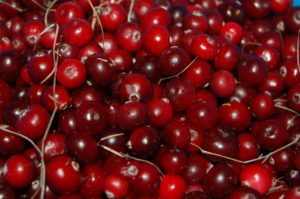 In 1816, cranberries began being commercially cultivated in the United States. Centuries before that Native Americans gathered wild cranberries for food, dye, and medicine. Pemmican—a mixture of cranberries, dried deer meat, and fat tallow that would last for months—provided a reliable source of protein and fat. Pemmican became a food staple of fur traders, essential to their survival on long journeys during the winter.
In 1816, cranberries began being commercially cultivated in the United States. Centuries before that Native Americans gathered wild cranberries for food, dye, and medicine. Pemmican—a mixture of cranberries, dried deer meat, and fat tallow that would last for months—provided a reliable source of protein and fat. Pemmican became a food staple of fur traders, essential to their survival on long journeys during the winter.
The colonists used cranberries in recipes they were familiar with from their native countries, substituting cranberries for the sour fruit called for in these recipes. In the 1620s, after the British brought honeybees to North America, a consistent supply of sweetener was available and cranberries began being used in pies, tarts, and cranberry sauce that was mostly eaten with white meats such as turkey. Although the commercial canning of cranberries began in 1912, the canned, gelatinous cranberry sauce that most Americans are familiar with did not become popular until 1940.
In 2012, the last year for which data are available,1 there were a total of 1,040 cranberry bogs and marshes in the United States, down from 1,134 in 2007. However, total acreage increased from 41,310 in 2007 to 43,918 in 2012. Most of the cranberries produced in the United States come from Wisconsin, Massachusetts, New Jersey, Oregon, and Washington State. In 2016, 35% of the cranberries harvested were sold overseas; a decade ago, 10% were. According to Kellyanne Dignan, senior manager of corporate communications at Ocean Spray Cranberries, more than 70% of U.S. shoppers who buy fresh cranberries use them for sauce for a holiday meal.
Today’s market size shows the number of pounds of processed and fresh cranberries sold in 2006 and 2015. Per capita, consumption of fresh cranberries remained flat between 0.08 and 0.10 pounds during this time period. However, processed cranberry consumption reached a high of 1.98 pounds per person in 2006, dropped to a low of 1.67 pounds in 2012, then increased yearly up to 1.93 pounds per person in 2015.
1 2017 data is currently being compiled for the Census of Agriculture by the United States Department of Agriculture. The data will be published starting in February 2019.
Geographic reference: United States
Year: 2006 and 2015
Market size: (Processed cranberry sales) 5,909,755 pounds and 6,203,247 pounds respectively
Market size: (Fresh cranberry sales) 258,454 pounds and 270,229 pounds respectively
Sources: “Report – Per Capita Cranberry Consumption,” U.S. Cranberries, Cranberry Marketing Committee, 2017 available online here; Whitman-Salkin, Sarah, “Cranberries, a Thanksgiving Staple, Were a Native American Superfood,” National Geographic, November 28, 2013 available online here; Blakemore, Erin, “A Brief History of Cranberries,” Smithsonian.com, November 25, 2015 available online here; “Table 40. Berries: 2012 and 2007,” 2012 Census of Agriculture, USDA, National Agricultural Statistics Service, May 2, 2014 available online here; “Cranberries,” United States Department of Agriculture, Economics, Statistics and Market Information System, August 10, 2017 available online here; Offner, Jim, “Marketers See Retail as Sweet Spot for Cranberry Sales,” The Packer, September 2, 2016 available online here; Offner, Jim, “Export Market Continues to Grow for Cranberry Industry,” The Packer, September 4, 2016 available online here; “Frequently Asked Questions,” USDA Census of Agriculture, United States Department of Agriculture, June 16, 2017 available online here.
Image source: alex80, “Cranberries-berry-red-vitamin-1714174,” Pixabay, August 2016 available online here.
